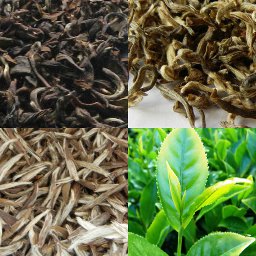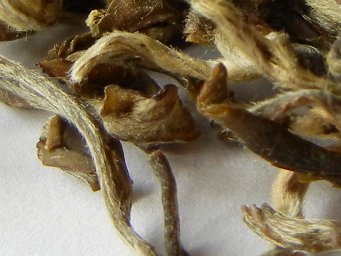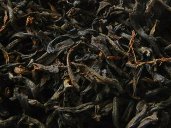Tippy Tea
Last Updated: Apr. 4, 2012
 Three tippy teas, and a picture of a live leaf bud of the tea plant.
Three tippy teas, and a picture of a live leaf bud of the tea plant.The standard reference point for the classification of tea as tippy is the orange pekoe grade, made from the top two leaves and leaf bud. Tippy teas range from teas containing a slightly higher proportion of tips or leaf buds than orange pekoe, to those made exclusively out of tips or buds.
The tippy or non-tippy status of a tea is reflected in its grade, with certain grades including the letter "T" as an abbreviation for tippy, e.g. TGFOP or FTGFOP. See our article on grades of tea for a more thorough explanation.
Tippy and non-tippy styles of tea
Some styles of tea are always tippy, as a defining feature of the style. These include silver needle white tea, oriental beauty oolong, huangya, and the black teas Yunnan gold and golden monkey, among many other styles. Teas with "buds" in the name are usually tippy. Breakfast teas, such as English Breakfast and Irish Breakfast, usually include a fair portion of tips in order to achieve a higher caffeine content, but are usually not made exclusively of buds, as the larger leaves impart a bolder flavor and darker color.At the other end of the spectrum, styles of tea low in tips include shou mei white tea and lapsang souchong. However, teas without leaf buds are not necessarily low grade or made of the largest leaves: for example, lu an melon seed is a style of green tea made only out of the first full leaf on the stalk, and containing neither buds nor more mature leaves.
Assessing portion of tips visually
 This green tea consisting only of tips shows the characteristic rolled appearance and downy white hairs characteristic of tea leaf buds.
This green tea consisting only of tips shows the characteristic rolled appearance and downy white hairs characteristic of tea leaf buds.Tips and buds also tend to be much smaller than mature leaves, but the size alone is not a good indicator of identifying tips, without a reference point, as different cultivars of tea plant have vastly different sizes of leaves. The tips from a large-leaf cultivar can be significantly larger than mature leaves from a small-leafed cultivar.
Differences in color of the dry leaf can also give you clues as to the portion of the tip. Across all styles of tea, the tips tend to range from lighter in color to the same color. The tips in white tea tend to retain a lighter color than the larger leaves, because the larger leaves undergo greater oxidation during the natural withering process.
 This loose-leaf Assam shows some orangish tip.
This loose-leaf Assam shows some orangish tip.With white, green, and oolong teas, the leaf tips often show fine downy hairs, usually with a whitish or silvery appearance. But this feature, as with others, also varies highly based on the cultivar of tea plant used.

